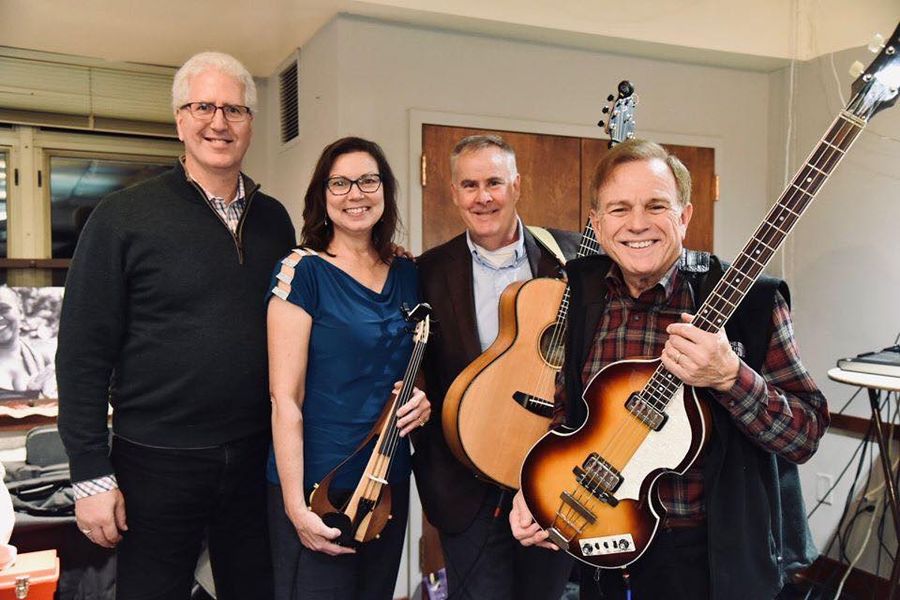By Peter Pavarini

For the past 12 years I’ve had the privilege of singing and performing with a very talented woman named Betsy. Back in the 1990s, a group of us middle-aged guys had the crazy idea of forming an Americana band to play charity events in our area. But it was not until Betsy joined our ensemble with her fiddle and amazing voice did the rest of us really learn how to tap our natural abilities. Just like a rookie quarterback who singlehandedly turns around a previously lackluster team, Betsy found a way to take us to a whole new level of musicianship.
To be clear, no one in our band ever had a serious expectation about making it in the music biz. Like countless other amateurs, our sole motivation was the joy of making music with friends in a non-judgmental context. Just experiencing a new song take shape from a few chords and some catchy lyrics was enough reason to keep pressing forward for nearly 30 years. Along the way, we’ve had some modest success playing any number of famous stages and raising money for a variety of good causes.
Betsy, on the other hand, was born to be a great talent. The daughter of a professional bluegrass musician, and previously a member of a number of bands including Throat Culture, a nationally-recognized acapella group, she could easily have made a living in music. Instead, she chose to be a wife and mother of 5 kids and stayed out of the limelight for the most part. Her musical “brothers” have been the beneficiaries of her decision.
The Voice That Holds It All Together
Thinking about the many hours of woodshedding a new song for public performance, I’m still at a loss for explaining why some numbers “click” and others don’t. We’ve always put the greatest effort into perfecting our vocal arrangements. Many other semi-professional bands feature better instrumentals than ours, so we’ve concentrated on using our combination of male and female voices to create a distinct and hopefully memorable sound. Needless to say, Betsy has been the voice that holds that all together. Whether she sings lead or harmony[i], the blend we create always depends on the strength and clarity of her singing.
Some vocal groups, such as barbershop quartets, think of harmonies in mathematical terms. Who will sing the lead, the third, the fifth, the octave? Employing that formula usually requires having singers with just the right vocal ranges. Although our band does have a variety of voices, our harmonies tend to evolve from finding the right mix of pitch, timing and amplitude –the way some of the famous mixed voice groups like the Mamas and the Papas, Little Big Town and Bryndle have succeeded.
Using any collection of voices to interpret a song is more of a journey than a destination. Properly arranged, the best songs are able to hold up in a variety of moods and venues and before audiences large and small. Ask any superstar why some live performances of their biggest hits “never made it onto the album”.
What Makes a Great Vocal Performance
But in every context, great vocal harmonies are not created without interpersonal harmony. Nothing influences a person’s singing more than interaction with other singers.
The human brain seems to be hard-wired to enjoy vocal harmony. Balanced, consonant soundwaves are simply easier for us to process and enjoy than dissonance. Beyond that, however, is something completely transcendental.
“Love is the harmony of two souls singing together.” – Gregory Godek
I’ve long believed, next to physical intimacy with someone you love, nothing is more magical than singing in harmony with people you enjoy being with.
One of my favorite bloggers, Anthony J. DeBlasi, has asked:
“Is the personality of an idea, an action, or a movement molded by the harmonic tendency to blend differences, calm and soothe frictions, orient molecules (words, colors, materials, people) into a sort of “crystalline formation” tuned to and in concert with an all-powerful Center?”[ii]
The Spice in Our Band
DeBlasi rightly points out that in all things, music being no exception, extreme individuality (extreme “counterpoint”) can end up in chaos and destruction. On the other hand, the quest for total concord (total “harmony”) can be equally destructive. Consider the current fascination with the notion of a One World Government. Playing the chords of a utopian society (think of Aldous Huxley’s “Brave New World” for example) comes at the expense of suppressing the best and brightest among us. In music as in life, it’s the surprising and unexpected notes that are the spice that make an unforgettable tune.
Betsy has been the spice in our band. Whether she’s soloing on a haunting number like “Wayfaring Stranger” or singing the obscure harmonies in a classic like “California Dreaming”, her contribution always brings a smile to my face – and to our audiences.
[i] In the simplest forms of vocal harmonies, the vocal melody is supported by a single backup vocal line which is either at pitch above or below the main vocal line. In more complex vocal arrangements such as the one our band often uses, different background singers with add consonant thirds, fifths and sixths (although occasionally a short passing note will violate these rules).
[ii] Anthony J. DeBlasi, “A View of the Creative Process Through a Musical Lens”, American Thinker, October 29, 2023.

Be First to Comment